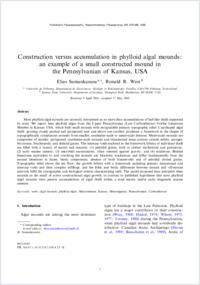Construction versus accumulation in phylloid algal mounds: an example of a small constructed mound in the Pennsylvanian of Kansas, USA
- Samankassou, Elias Geology and Paleontology Unit, Department of Geosciences, University of Fribourg, Switzerland
- West, Ronald R. Kansas State University, Department of Geology, Thompson Hall, Manhattan, KS 66506, USA
-
01.08.2002
Published in:
- Palaeogeography, Palaeoclimatology, Palaeoecology. - 2002, vol. 185, no. 3-4, p. 379-389
English
Most phylloid algal mounds are currently interpreted as no more than accumulations of leaf-like thalli supported by mud. We report here phylloid algae from the Upper Pennsylvanian (Late Carboniferous) Frisbie Limestone Member in Kansas, USA, which built small mounds with recognizable primary topographic relief. Cup-shaped algal thalli, growing closely packed and juxtaposed near and above one another, produced a framework in the shapes of topographically conspicuous mounds from smaller, centimeter-scale to meter-scale features. Meter-scale mounds are composites of smaller, juxtaposed, centimeter-scale mounds and intramound areas contain crinoid debris, sponges, bryozoans, brachiopods, and skeletal grains. The intercup voids enclosed in the framework fabrics of individual thalli are filled with a variety of matrix and cements: (1) peloidal grains, both in clotted wackestone and grainstone; (2) early marine cement; (3) microbial encrustations, often oriented against gravity; and (4) mudstone. Bedded limestones equivalent to and overlying the mounds are bioclastic wackestone and differ fundamentally from the mound limestone in facies, biotic components, absence of both frameworks and of peloidal clotted grains. Topographic relief above the sea floor, the growth fabrics with a framework including primary intramound and intercup voids and their complex infillings, and the lithic and biotic differences between mound and off-mound intervals fulfil the stratigraphic and biological criteria characterizing reefs. The model proposed here interprets these mounds as the result of active constructional algal growth, in contrast to published hypotheses that most phylloid algal mounds were passive accumulations of algal thalli within a mud matrix and/or early diagenetic marine cements.
- Faculty
- Faculté des sciences et de médecine
- Department
- Département de Géosciences
- Language
-
- English
- Classification
- Geology
- License
-
License undefined
- Identifiers
-
- RERO DOC 5001
- DOI 10.1016/S0031-0182(02)00425-X
- Persistent URL
- https://folia.unifr.ch/unifr/documents/299812
Statistics
Document views: 189
File downloads:
- Texte intégral: 412
